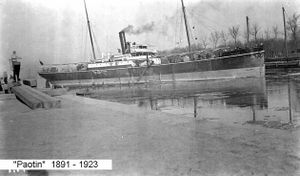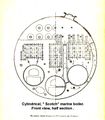Paoting
Sister ship of "Kweilin I"
Contents
History
Paoting was designed for the carriage of coastal freight and steerage passengers. The seasonal southbound carriage of cheap-fare passengers on deck, (sheltered by canvas awnings), was a mainstay of The China Navigation Company’s coast trade in the summer months.
In the north, in terms of freight other than beancake, the most commercially important of the northern ports was Tientsin, located some forty miles inland on the Hai Ho River. The small coasters of the 1890s, such as Paoting, were designed with the Tientsin River in mind, and were all around 250-260 feet in length.
The Hai Ho was prone to constant silting and only narrow one-lane shipping channels were kept clear by dredging. Two vessels meeting head-on in the river could not therefore alter course in good time, to pass each other in the usual way, because the parallel displacement of water in the narrow channel might well throw one or other ship up onto the bank. The accepted method was to steer a collision course until the last possible minute, when both vessels would swing to starboard and pass within a cables-length of one another.
At Tientsin itself, the river was too narrow to allow vessels to turn completely, even with the aid of a tug. For this reason the “Stern-line Swing” was developed. This ‘turning on a sixpence’ method made use of a semi-circular bay cut out of the river bund, close to the main city berths.
Turning was effected by means of a mooring cable, (known as the “Turning Spring”), stretched between the aft winch and a bollard ashore. As the “spring” was tightened, the ship’s stern was pulled into the basin, swinging the bow into mid-stream, where it was carried round by the current until the vessel was facing downstream.
The picture opposite - taken in 1907 - shows Paoting on the “Swinging Berth”, in an icy Tientsin River.
Paoting continued in the coast trade until the close of the beancake season in 1923, when she was sold to breakers.
Service
China Coast trades, a beancaker, Refer to "Kweilin I" and "Sungkiang"



